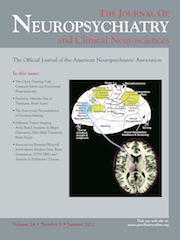Charles Bonnet Syndrome Responding to Amisulpride
To The Editor: The term “Charles Bonnet Syndrome” (CBS) was coined by de Morsier in 1938, after the man who described and later himself developed the condition1. It consists of a triad of complex visual hallucinations, ocular pathology, and normal cognitive status. The vivid and complex visual hallucinations are recognized as unreal and occur in the absence of any other psychiatric symptoms and with full insight.2 The present case report describes a patient who developed CBS and demonstrated an unusual treatment response.
A 45-year-old married man presented to the psychiatry outpatient department with a 6-month history of increasingly complex visual experiences that he recognized as unreal. These had started as “ugly, unfamiliar faces,” episodically, for up to 2-hour periods daily. After about 3 months, he began to see frightening pictures of road traffic accidents, earthquake-affected cities, and countries affected by floods, wars, etc. These experiences gradually become more frequent and occurred many times a day. They were never accompanied by clouding of consciousness or hallucinations in any other modality. He described the experiences as vivid and occurring in external space, while always recognizing them as unreal. He was not consciously able to control their occurrence or content, and described the experience as mostly unpleasant. There was no past or family history of psychiatric disorder, epilepsy, drug dependence, or chronic physical illness. On mental state examination, he was a tidy, cooperative man. There were no disturbances in orientation or memory. He described his mood as normal and gave a detailed, coherent description of his visual experiences. There were no hallucinations in any other modality. He did not have any formal thought disorder. Insight and judgment were intact. The routine blood and urine examinations, fundus oculi, intraocular pressure, perimetry, electroencephalogram (EEG), and MRI brain scan were normal. He was then started on amisulpride 100 mg daily, which was gradually increased to 200 mg, and, over the next 3 weeks, there was a reduction in his symptoms. At follow-up 3 months later, he had had no recurrence of symptoms.
CBS has been described most frequently in elderly people,3 but the present patient was middle-aged. It usually occurs in association with visual impairment, but our patient had no visual disturbances. Although the EEG was normal, his symptoms resolved completely with amisulpride.
The exact etiology of CBS is not known. It has been described in association with lesions of the visual system ranging from the lens of the eye to the occipital cortex, as well as lesions in areas not associated with the visual system4. CBS is usually self-limiting, even in those cases where the organic lesion is permanent. CBS has been successfully treated with medications including carbamazepine, valproate, selective serotonin reuptake inhibitors, olanzapine, and gabapentin5. This is the first case report describing the role of amisulpride, an atypical neuroleptic.
1 : The Charles Bonnet syndrome in perspective. Psychol Med 1982; 12:251–261Crossref, Medline, Google Scholar
2 : The Charles Bonnet syndrome: a review. J Nerv Ment Dis 1997; 185:195–200Crossref, Medline, Google Scholar
3 : Charles Bonnet syndrome: a description of two cases. Acta Psychiatr Scand 1990; 82:316–317Crossref, Medline, Google Scholar
4 : Isolated visual hallucinations and the Charles Bonnet syndrome: a review of the literature and presentation of six cases. Compr Psychiatry 1989; 30:90–98Crossref, Medline, Google Scholar
5 : Successful treatment of hallucinations associated with sensory impairment using gabapentin. J Neuropsychiatry Clin Neurosci 2008; 20:364–366Link, Google Scholar



